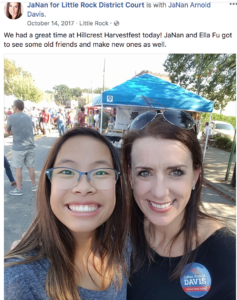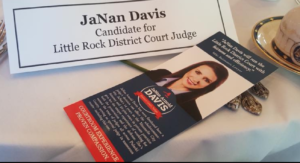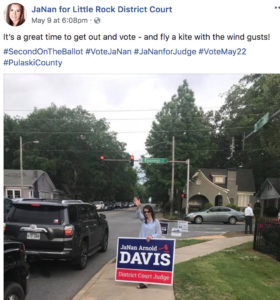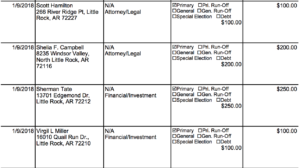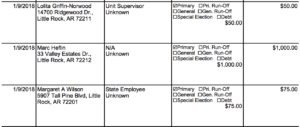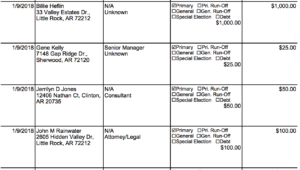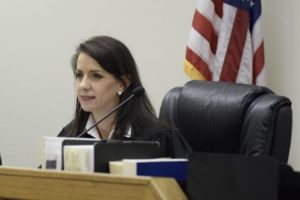 If you followed along with our Tournament of Fools,1 you might have noticed this post from March 14, wherein we wrote:
If you followed along with our Tournament of Fools,1 you might have noticed this post from March 14, wherein we wrote:
Luckily for Davis, her plan to simply ignore the rules and play the game her own way went unchecked for yet another round. Observers had no explanation for it. “It’s like…everyone else is playing by the same rules, and she’s just ignoring them entirely, but nobody seems to care,” said one fan. “How can she do that?” asked another. “Aren’t there requirements about who has to do certain things when?”
That snarky blurb was an allusion to the fact that, as of the date of that post, Little Rock District Court Judge candidate JaNan Arnold Davis had not filed any financial disclosures, despite having been campaigning for the position since late October or early November of 2017.
You see, under Arkansas law, once a candidate is accepting funds, certain reporting deadlines kick in, and the first deadline for Davis would have been the Fourth Quarter 2017 report, which was due by January 15, 2018. Then, because 2018 is an election year, Davis was responsible for monthly reports starting with January, with the January report due by February 15, the February report due by March 15, etc.
On March 15, Davis finally filed her Fourth Quarter 2017 report, along with her January and February reports (though the February report was later amended on April 3). So, by the time we were originally going to report on her lack of filings, that part had been corrected.
Thing is, if you spend five minutes comparing the reports to reality, a whole new set of issues crop up.
For instance, a quick check of Davis’s campaign Facebook page shows that she had campaign buttons at least as far back as October 14, 2017.
Buttons aren’t free, of course, so one would expect to see an expenditure for the buttons on the Fourth Quarter 2017 report. Except there isn’t one. In fact, there are no expenditures on that report. “But, wait!” you might be saying. “What if the buttons were free?!” Well, devil’s advocate, that would not matter, because even a “free” thing like that must be reported as an in-kind contribution to the campaign, which it also was not. The purchase (or in-kind contributions) of the buttons don’t show up on the January, February, or March reports, either (including the amended February and amended March reports).
Similarly, we know she has campaign cards:
And signs:
No expenditures for those appear in any of the reports as well.
“Well, maybe,” you might suggest, trying to give her every benefit of the doubt, “those expenditures were made by someone or something else, like a campaign committee.” And I see where you could get that idea, inasmuch as Davis’s campaign Facebook page says “Advertisements and marketing paid for by The Committee to Elect JaNan.”
Except, there’s a couple problems with that. First, and most obvious, the quarterly/monthly reports that candidates file have a specific box on them that asks, “Does the candidate have a campaign committee?” If the candidate checks the “Yes” box, then they have to provide additional information about the committee, including naming a treasurer. Here’s what every one of those boxes looks like on Davis’s forms:
But…maybe it’s not a campaign committee? Well, it can’t be an independent-expenditure committee, since buying the signs/advertisements FOR a candidate would obviously (even to Arkansas’s Ethics Commission) be an improper coordination between candidate and committee. It can’t be an exploratory committee–or at least not a valid, proper one, I suppose–because state law requires that an exploratory committee register with either the county clerk or the Secretary of State, depending on the race, and there is no such registration in either location for a Davis exploratory committee. Exploratory committees also are supposed to transfer any funds raised for a person to that person once he or she becomes a candidate, since that person is no longer “exploring” the possibility of running and is now actually running. (UPDATE: More accurate thoughts on this committee issue in this post.)
So, no, it doesn’t appear that the payment for the signs, buttons, etc., could have been made by some other committee. Besides, if they were, that would be a bigger problem, since “contribution” includes “anything of value [given] to a candidate…for the purpose of influencing the nomination or election of any candidate.” So the fact that Davis has the buttons, signs, etc. means, if they were purchased by some other person or group, they have been given to Davis for her campaign and should have been reported as (and subject to the limits on) in-kind contributions.
Digging further into the reports, things do not get better. A campaign finance report is required to contain certain information including, as is relevant here, “name and address of each person, including the candidate, who made a contribution or contributions that in the aggregate exceeded fifty dollars ($50.00)” and “The contributor’s principal place of business, employer, occupation, the amount contributed, the date the contribution was accepted by the candidate, and the aggregate contributed for each election.” While her Fourth Quarter 2017 report managed to get the information about all of the contributors, Davis apparently assumed that these requirements were optional whenever it was inconvenient to follow them.
From her January report, 11 of her 13 donors are missing information, including several where the employer is listed as “N/A,” but the person is shown with an occupation. The law seems to think that the employer information is applicable, so “N/A” is rather odd way of reporting that information:
Her February report (as amended) has 6 of the 14 donors with either missing employer, missing occupation, missing street address, or some combination of those, including a particular egregious entry that shows an utter lack of bare minimum effort toward record keeping:
The March report (as amended) takes a different approach and, rather than listing “N/A” for the employers, just calls nearly everyone self employed and gives a vague description of the occupation. Yet, because Google is our friend, we can quickly check and see that a number of those are not self-employed.
- Edward Vance is listed as “Self Financial/Investment.” In reality, he’s an executive with Access Credit Management.
- Jerry Carlisle is listed as “Self General Business.” However, he appears to be the Chairman of Business World, Inc.
- MG Nash is listed as “Self Attorney/Legal.” That would be Mary Nash who is the senior lawyer at, and employed by, Nash Law Firm. Mary Nash is also literally a person who is hosting a fundraiser for Davis AT NASH LAW FIRM.
- Scott Swander is listed as “Self Financial/Investment.” But he is actually the president of Synergy Wealth Management.
That information was easily located in less than 10 minutes. More importantly, that information is required on a campaign finance report. Yet Davis could not be bothered to contact the donor or find that information on the internet before filing her report? She figured that incorrectly claiming that each of those people was self employed was both acceptable and the better option?
There are only a few explanations for such shoddy reporting, none of which are good. Regarding the signs and buttons, either she has not bothered to report that expenditure or she did not properly report those as in-kind contributions from some other person or group; in either case, why she would think that the cost of signs was not something that would be reported on a campaign contribution and expenditure report is unclear. Regarding the sloppy and incomplete records of donors to her campaign, either: she did not know what the law required and did not bother to look; she looked at the law but did not understand the requirements; she knew what the law required but did not bother to follow it, either out of laziness or because she did not think it mattered. None of those is a good look for a wannabe judge.
Earlier today, Russ Racop posted about how Davis’s continued references to sitting as a special judge in district court appear to violate certain judicial rules that apply to candidates as well as judges. When you combine that story with the poor judgment on display above, it becomes very hard to justify supporting JaNan Arnold Davis as a District Court Judge, especially when there are better candidates available.
No, it never wrapped up. Yes, it bothers me. No, I probably won’t do anything about that.↩
